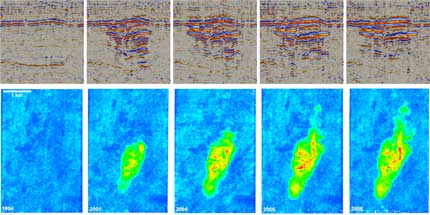Operator: StatoilHydro
 Images of the CO2 plume at Sleipner from the time-lapse 3D seismic data, showing the baseline survey in 1994 and growth of the brightly reflective plume on subsequent surveys. Top panels show a vertical cross-section through the plume, bottom panels show a plan view of the Utsira reservoir and the plume footprint (courtesy of Statoil)
Images of the CO2 plume at Sleipner from the time-lapse 3D seismic data, showing the baseline survey in 1994 and growth of the brightly reflective plume on subsequent surveys. Top panels show a vertical cross-section through the plume, bottom panels show a plan view of the Utsira reservoir and the plume footprint (courtesy of Statoil)
Sleipner is the world’s first CO2 injection project aimed at emissions mitigation. In 1995, the Norwegian government implemented a tax on CO2 emissions and this was an incentive for Norwegian energy company Statoil to start experimenting with CCS on this off shore gass rig.
The Sleipner CO2 storage operation commenced in 1996, and remains the world’s most mature large-scale demonstration of storage technology with >7 Mt of CO2 currently in situ. Current time-lapse seismic surveys provide a unique, world-leading reference dataset applicable to the general understanding of large-scale storage in saline aquifers
Time lapse 3D (4D) seismic data were acquired in 1994, prior to injection, and again in 1999, 2001, 2002, 2004, 2006 and 2008 with more than 11 million tonnes of CO2 in the reservoir at the time of the last survey.
 (courtesy of Statoil)
(courtesy of Statoil) Spectacular seismic images have been obtained, with the plume of injected CO2 imaged as a number of bright sub-horizontal reflections, above and around the injection point. The reflections are interpreted as wavelets from thin (just a few metres thick) layers of CO2 trapped beneath intra-reservoir beds of shale. The data shows the precise subsurface location of the CO2 plume and confirms that the CO2 is confined securely within the storage reservoir.
In addition to the 3D seismic, other monitoring surveys have been deployed, including high resolution 2D seismic (in 2006), seabed gravity (in 2002, 2005 and 2009), seabed controlled source electromagnetics (CSEM) (in 2008), and seabed imaging and bathymetry (in 2006).
Current research work in CO2ReMoVe at Sleipner is focused on understanding detailed migration processes within the plume by relating the seismic signals directly to CO2 distributions and amounts in the reservoir and history matching numerical flow simulations with the observed data.


